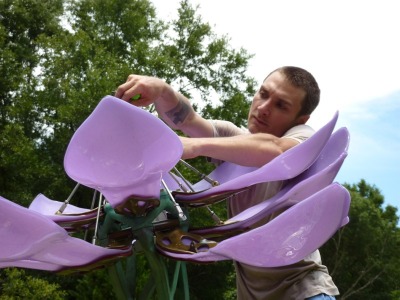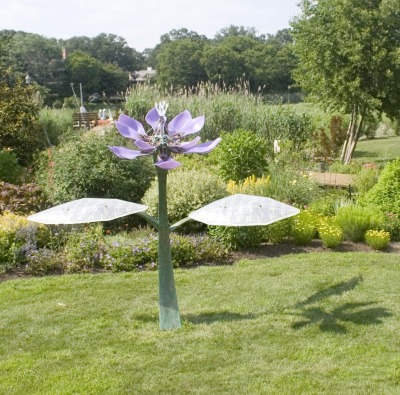 Heliotropis, a recently-completed work by Anthony Castronovo, is perhaps atypical even in the rather rarefied genre of ten-foot tall flower sculptures, given its LED technology, solar panels, sensors for monitoring temperature, humidity, wind speed, and ground vibrations, in addition to a sensor that tracks light, allowing for the flower’s glass petals to “bloom” in the morning and for an LED light-fixture to be activated in the evening. Take that, Balloon Flower!
Heliotropis, a recently-completed work by Anthony Castronovo, is perhaps atypical even in the rather rarefied genre of ten-foot tall flower sculptures, given its LED technology, solar panels, sensors for monitoring temperature, humidity, wind speed, and ground vibrations, in addition to a sensor that tracks light, allowing for the flower’s glass petals to “bloom” in the morning and for an LED light-fixture to be activated in the evening. Take that, Balloon Flower!
Commissioned by Beth Deutch, founder and medical director of HerSpace Breast Imaging Associates, along with her husband, Larry Rubin, the sculpture stands in the garden of the couple’s home. Besides all those electronics, Heliotrope features a stem made of bronze and petals made of glass. Castronovo had this to say about the work in a press-release: “Heliotropis creates a definite visual link between its physical form and the conditions of its immediate environment. This relationship explores the interactions between machine and nature… see my sculptures and interactions as energy generators, spinning through space and creating energy from matter and time.”
Interestingly, Heliotropis is a machine that effectively eliminates the mediator — “human” — from the typical “man vs. machine” or “man vs. nature” equation. The sculpture responds on its own to its environment, opens and closes based on its own sensors, and has a direct relationship to its form of energy, the sun (unlike an automobile that, for now at least, requires a human being to fuel it).
 Anthony Castronovo at work on Heliotropis
Anthony Castronovo at work on Heliotropis
It’s not clear whether Heliotropis is designed to share any of the information it collects about its environment, or whether it simply uses that data to perform specific choreographed motions. In this way, it is more like an actual flower or any other plant in nature, that doesn’t especially give a damn about sharing its secrets with people. Heliotropis is then a bit of an anomaly in the history of technology: a machine made without the primary goal of serving human interests. It is a machine with a secret — this is perhaps what constitutes it as an art-object.
 If you’re asking yourself something like “Yes, it’s a big flower with solar panels that acts like a real flower, but why?”, I would like to suggest that Heliotrope presents a more awe-inspiring picture than most technology these days. Computers, televisions, cell phones, mass-produced technology in general, have become predictable, even banal, to us (with a few exceptions such as the iPhone, which remains a wonder to behold) due in part to their incessant serving of every little human need and want. Heliotropis retains a mystery about it through its clunky simulation of a plant in nature. The fact that its raison d’être is somewhat obscure highlights both the mystery of the art-object itself – the aura that continues to elicit our attention to fundamentally useless objects, as well as the mystery of technology, which is defined precisely by its usefulness.
If you’re asking yourself something like “Yes, it’s a big flower with solar panels that acts like a real flower, but why?”, I would like to suggest that Heliotrope presents a more awe-inspiring picture than most technology these days. Computers, televisions, cell phones, mass-produced technology in general, have become predictable, even banal, to us (with a few exceptions such as the iPhone, which remains a wonder to behold) due in part to their incessant serving of every little human need and want. Heliotropis retains a mystery about it through its clunky simulation of a plant in nature. The fact that its raison d’être is somewhat obscure highlights both the mystery of the art-object itself – the aura that continues to elicit our attention to fundamentally useless objects, as well as the mystery of technology, which is defined precisely by its usefulness.
A meeting of worlds in this case discloses something of the problem at the very heart of man’s relation to nature – which also exists on this axis between purely aesthetic fascination and pure object for human dominance. The catch is that Heliotropis makes its point about nature through being man-made. Perhaps this is a harbinger of a world to come (or that has already partially arrived), in which man-made technology is nature as much as flowers are.
—Lee Gaizak Brooks


